|
|
|
|
|
Oil On
Canvas, Real Flavor of Old Masters
|
|

|
ARTWORKS
INDEX
A B C D E F G H I J K L M N O P Q R S T U V W X Y Z |
ARTISTS
INDEX
A B C D E F G H I J K L M N O P Q R S T U V W X Y Z |
|
|
| | |
|
|
 |
Johannes Deiker -- Click Here
|
|
painted Schwarzer Setter apportiert Hasen in winterlicher Landschaft in 1886
1822-1895 |
|
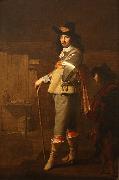 |
Johannes Cornelisz Verspronck -- Click Here
|
|
(between 1600 and 1603, Haarlem - buried June 30, 1662, Haarlem) was a gifted Dutch Golden Age portraitist.
He was the son of the painter Cornelis Engelsz from Gouda, who taught him to paint portraits. In 1632 he became a member of the Haarlem Guild of St. Luke and started a successful career as a portraitist of mostly Catholic sitters in Haarlem. He may have been a Frans Hals pupil, and was strongly influenced by him, especially in his natural expressions and relaxed poses. He is best known for his exactness in painting details such as jewelry and lace, which made him quite popular with female sitters. Most notably, he won a lucrative commission in 1642 for a group portrait of the regentesses of the St. Elisabeth Gasthuis, at the time the wealthiest charity institution in Haarlem. This was won at the expense of Frans Hals himself, who had painted the regents of the St. Elisabeth Gasthuis in 1641 and fully expected to win the commission for the women. |
|
 |
johannes brahms -- Click Here
|
|
Born: 7 May 1833
Birthplace: Hamburg, Germany
Died: 3 April 1897 (liver cancer)
Best Known As: German composer of "Brahms' Lullaby" ("Wiegenlied")
|
|
 |
Johannes Bosboom -- Click Here
|
|
(born The Hague, February 18, 1817 - died there September 14, 1891) was a Dutch painter and watercolorist of the Hague School, known especially for his paintings of church interiors.
At the age of 14 he became a student of Bartholomeus van Hove and painted in his studio along with Van Hove's son Hubertus van Hove. Together they worked on the pieces of scenery that Van Hove created for the Royal Theatre in The Hague. In addition, Bosboom took lessons from 1831 to 1835 and again from 1839 to 1840 in the Hague Academy of Art. Here he also made the acquaintance of Antonie Waldorp and Wijnand Nuyen.
The young Bosboom traveled to Germany in 1835 to Dusseldorf, Cologne and Koblenz and painted the watercolor View of the Mosel Bridge at Koblenz. This painting was purchased by Andreas Schelfhout, who became his confidante and friend. In 1939 he traveled to Paris and Rouen and received a silver medal for View of the Paris Quay and the Cathedral at Rouen. He also painted a number of church interiors, a relatively traditional genre in which the seventeenth century artists Pieter Saenredam and Emanuel de Witte served as important examples. Bosboom had a great deal of success with these pieces, and for the rest of his career he would repeatedly return to this theme, which was the one in which he would achieve his greatest fame.
Bosboom's choice of subject matter may seem to isolate him from the rest of the Hague School, but his search for ways to reproduce the spatial atmosphere through light, shadow, and nuances of color places him in the very mainstream of this group. In 1873, during a stay in Scheveningen, he painted many watercolors of town views, the dunes, the beach and the sea. It is possible that these watercolors encouraged Hendrik Willem Mesdag and Jacob Maris to concentrate further on the sea and beach as subjects.
|
|
 |
Johannes Adam Oertel -- Click Here
|
|
German, 1823-1909 |
|
 |
Johann-Baptist Lampi the Elder -- Click Here
|
|
painted Portrait of Paweł Grabowski. in1790 |
|
 |
Johann Zoffany -- Click Here
|
|
German
(Resident in Britain)
1734-1810
Johann Zoffany Galleries
Painter of portraits, conversation pieces, and theatrical scenes, Zoffany was born in Germany and came to England about 1758 after studying in Italy. He began by painting clock faces and doing hack work, before turning to painting theatrical scenes, especially depicting David Garrick. He was favoured by the royal family. George III nominated him for the Royal Academy in 1769 and recommended him to the duke of Tuscany. |
|
 |
Johann Wolfgang von Goethe -- Click Here
|
|
Frankfurt 1749-1832 Weimar,was a German writer and according to George Eliot, "Germany's greatest man of letters and the last true polymath to walk the earth." Goethe's works span the fields of poetry, drama, literature, theology, humanism and science. Goethe's magnum opus, lauded as one of the peaks of world literature, is the two-part drama Faust. Goethe's other well-known literary works include his numerous poems, the Bildungsroman Wilhelm Meister's Apprenticeship and the epistolary novel The Sorrows of Young Werther. Goethe was one of the key figures of German literature and the movement of Weimar Classicism in the late 18th and early 19th centuries; this movement coincides with Enlightenment, Sentimentality (Empfindsamkeit), Sturm und Drang and Romanticism. The author of the scientific text Theory of Colours, he influenced Darwin with his focus on plant morphology. He also served at length as the Privy Councilor ("Geheimrat") of the duchy of Weimar. Goethe is the originator of the concept of Weltliteratur ("world literature"), having taken great interest in the literatures of England, France, Italy, classical Greece, Persia, Arabic literature, amongst others. His influence on German philosophy is virtually immeasurable, having major effect especially on the generation of Hegel and Schelling, although Goethe himself expressly and decidedly refrained from practicing philosophy in the rarefied sense. Goethe's influence spread across Europe, and for the next century his works were a major source of inspiration in music, drama, poetry and philosophy. Goethe is considered by many to be the most important writer in the German language and one of the most important thinkers in Western culture as well. |
|
 |
Johann Wilhelm Schirmer -- Click Here
|
|
Julich 1807-1863 Karlsruhe,was a German landscape artist from Julich, within the Prussian Duchy of Julich. The artist, a namesake of Friedrich Wilhelm Schirmer, had a similar aim and career. He first was a student, and subsequently became a professor in the academy of Dusseldorf. He became known as one of the first of the so-called Dusseldorf landscape school. In 1854 he was made director of the art school at Karlsruhe, where he died. |
|
 |
Johann Wilhelm Preyer -- Click Here
|
|
painted A Still Life with Peaches and Grapes on a Marble Ledge in 1803-1889 |
|
 |
Johann Walter -- Click Here
|
|
painted Gustavus Adolphus of Sweden at the Battle of Breitenfeld in 1632 |
|
 |
johann tischbein -- Click Here
|
|
Johann Heinrich Wilhelm Tischbein, also known as Goethe-Tischbein (15 February 1751 in Haina ?C 26 February 1828 in Eutin) was a German painter. He was a descendant of the Tischbein family of painters, and a pupil of his uncle Johann Jacob Tischbein.
Like many contemporary colleagues, Tischbein lived in Rome for some years. During his first stay in Rome (1779?C1781) his style changed from Rococo to Neoclassicism. He painted landscapes, historical scenes and still lifes. His second stay in Rome lasted 16 years (1783?C1799). He met Johann Wolfgang von Goethe there in 1786, made friends with him and accompanied him to Naples in 1787. Later, Goethe recounted this travel in his Italian Journey. Also in 1787, Tischbein painted his most famous work, a portrait of Goethe as a traveller in the Roman Campagna (now in the Städel museum, Frankfurt am Main).
From 1808, Tischbein was a painter at the court of Oldenburg in Northern Germany.
|
|
 |
Johann Rudolf Huber -- Click Here
|
|
Johann Rudolf Huber (April 21, 1668; February 24, 1748) was an eminent Swiss portrait artist. Among his famous subjects were Charles III William, Margrave of Baden-Durlach, Joseph I, Holy Roman Emperor and Albrecht von Haller .
|
|
 |
Johann Peter Krafft -- Click Here
|
|
(15 September 1780 - 28 October 1856) was a German-Austrian painter.
Krafft was born in Hanau, Hesse. At the age of ten, he began his art studies at the Hanau Akademie. In 1799, he moved to Vienna and studied at the Academy of Fine Arts for three years under the tutelage of Heinrich Feger. From 1802 to 1808, he studied in Paris, with Jacques-Louis David and François Gerard, and then in Rome. On his return to Vienna, he became a successful professional painter, producing numerous portraits.
In 1828, Krafft became director of the Imperial and Royal Picture Gallery in Belvedere Palace.
Johann Peter Krafft died at the age of 76 in Vienna, where he was buried at the Zentralfriedhof. |
|
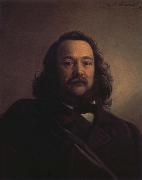 |
Johann Peter Hasenclever -- Click Here
|
|
1810 Remscheid-1853 Dusseldorf, German painter. His artistic talent was recognized in 1827, while he was at school in D?sseldorf. The same year he embarked on a course in architecture at the Akademie in D?sseldorf. In 1828 he turned to the study of history painting. After a difference of opinion over the theory of art with the Director of the Akademie, Wilhelm von Schadow, Hasenclever went home to Remscheid. There he taught himself portrait painting. An example of his work from this period is the portrait of Gertraude Scharff (1832-3; Remscheid, Dt. Werkzeugmus. & Heimatmus.). From 1832 to 1838 Hasenclever again studied at the Akademie in D?sseldorf in a painting class taught by Ferdinand Theodor Hildebrandt (1804-74). In portraits and humorous genre paintings Hasenclever found a field suited to his gifts. Pithy commentaries on the everyday life of the lower middle classes are present in all of Hasenclever's work. He was best known for subjects such as wine-tastings and cellar scenes, and he also made a series of Jobs pictures, humorous, ironic interpretations of popular life based on the poem 'Jobsiade', a grotesque and comic heroic epic written by Carl Arnold Kortum in 1784. |
|
 |
Johann Niklaus Grooth -- Click Here
|
|
Germany (1723 -1797 ) - Painter
|
|
 |
Johann Nepomuk Rauch -- Click Here
|
|
(1804 Vienna - 1847 Rome) was a very significant Austrian Biedermeier painter of the 1st half of the 19th century. |
|
 |
Johann Moritz Rugendas -- Click Here
|
|
Augsburg 1802-1858 Weilheim an der Teck,was a German painter, famous for his works depicting landscapes and ethnographic subjects in several countries in the Americas, in the first half of the 19th century. Rugendas was born to the seventh generation of a family of noted painters and engravers of Augsburg (he was a grandson of Georg Philipp Rugendas, 1666-1742, a celebrated painter of battles), and studied drawing and engraving with his father, Johann Lorenz Rugendas II (1775-1826). From 1815 to 1817 he studied with Albrecht Adam (1786-1862), and later in the Academy de Arts of Munich, with Lorenzo Quaglio II (1793-1869). Inspired by the artistic work of Thomas Ender (1793-1875) and the travel accounts in the tropics by Austrian naturalists Johann Baptist von Spix (1781-1826) and Carl von Martius (1794-1868), Rugendas arrived in Brazil in 1821, where he was soon hired as an illustrator for Baron von Langsdorff's scientific expedition to Minas Gerais and Sao Paulo. Langsdorff was the consul-general of the Russian Empire in Brazil and had a farm in the northern region of Rio de Janeiro, where Rugendas went to live with other members of the expedition. In this capacity, Rugendas visited the Serra da Mantiqueira and the historical towns of Barbacena, Sao Joao del Rei, Mariana, Ouro Preto, Caete, Sabara and Santa Luzia. |
|
 |
Johann Michael Sattler -- Click Here
|
|
(28 September 1786, Herzogenburg, Lower Austria - 28 September 1847, Mattsee, Salzburg) was an Austrian portrait and landscape painter, best known for his large-scale panoramas.
Sattler attended the Vienna Academy beginning in 1804 under the tutelage of Hubert Maurer. In 1819 Sattler moved to Salzburg, where in 1824 he began to paint a 360-degree panorama of the city as seen from the top of Salzburg's castle. The massive work covered 125 square metres and was first exhibited in 1829. Salzburg made him an honorary resident. Stattler toured across Europe with the painting for ten years, writing about his return in 1838, "with 30 tons and crossing approximately 30,000 kilometres of land and water, a feat no one had ever done before me and one which would be difficult to repeat in the future." Satler's son, the artist Hubert Sattler, donated the work to the city in 1870. The painting is now on display at the Salzburg Museum in a specially designed area called the Panorama Museum. |
|
 |
Johann Michael Rottmayr -- Click Here
|
|
Austrian,1654-1730
Austrian painter and draughtsman. He is most notable for large-scale religious and secular decorative schemes, and his career heralded the important 18th-century German contribution to late Baroque and Rococo fresco painting. He was probably taught by his mother, who was a painter of wooden sculpture. Between 1675 and 1687-8 he was in Venice as a pupil and assistant of the Munich artist Johann Carl Loth, whose studio attracted many painters from Austria and southern Germany. It is possible that Rottmayr also visited other Italian cities, in particular Bologna and Rome. He returned to Salzburg in the late 1680s a mature painter and immediately received commissions for panels and frescoes. In 1689 he painted mythological scenes for the Karabinierisaal at the Residenz in Salzburg (in situ); in composition and style these are close to high Baroque models, particularly the work of Pietro da Cortona and Peter Paul Rubens. Such models, as well as the example of Loth, and Venetian painting, had an important influence on Rottmayr's panel paintings of this period, for example the Sacrifice of Iphigenia (c. 1691; Vienna, Belvedere) or St Agnes (1693-5) and St Sebastian (1694; both Passau, Cathedral). In these, the solidity of the figures is emphasized through the use of intense colours. For Rottmayr, however, the rational development of the figures and the composition was less important than the overall effect achieved by the use of colour. Incorrect details of anatomy and perspective found compensation in greater expressiveness, mainly conveyed by gesture and pose. Rottmayr's images are filled with plastic elements, creating a staccato effect. Several very important early commissions paved the way for Rottmayr's move to Vienna in the late 1690s. |
|
 |
Johann Michael Franz -- Click Here
|
|
Seine Eltern waren der Zimmermeister Jakob Franz , und Anna geb. Lueger. Seine Ausbildung genoss er im Umkreis des Augsburger Reichsstädtischen Kunstakademiedirektors Johann Georg Bergmuller (Bergmiller) (1688-1762); nach eigenen Angaben schloss er sie 1733 ab. |
|
 |
johann melchior wyrsch -- Click Here
|
|
johann melchior wyrsch (1732-98) was born in buochs, switzerland. in 1753 he went to rome to study with gaetano lapis and then at the academie francaise. |
|
 |
Johann Martin Stock -- Click Here
|
|
(1742 - 1800)
Budapest, Magyar Nemzeti Galeria |
|
|
|
 |
Johann Ludwig Aberli -- Click Here
|
|
Swiss, 1723-1786, Swiss painter, draughtsman and engraver. In 1741 he moved to Berne, where he took drawing lessons with Johann Grimm (1675-1747), whose school of drawing he took over in 1747. He visited the Bernese Oberland with Emanuel Handmann, Christian Georg Schetz (1718-91) and Friedrich Wilhelm Hirt (1721-72) in 1759 and in the same year travelled to Paris with Adrian Zingg (1734-86). This was his only trip abroad, but it determined him to work exclusively as a landscape painter. After nine months he returned to Berne, where his landscape views became popular, particularly with foreign travellers, enamoured of 'Nature' and keen to retain souvenirs of their travels. He was one of the first artists to portray the beauties of the Swiss countryside; his favourite subjects were the Aare Valley and views of Swiss lakes (e.g. View of Erlach on the Lake of Biel; Berne, Kstmus.). He invented a technique known as the 'Aberli style', which consisted of watercolour washes added to an image in which slightly smudged outlines were achieved through a combination of engraving and etching. The prints were made from drawings taken from nature and finished in the studio. His style was characterized by delicate execution, an intimate narrative approach, refined colours and the ability to convey a light and vaporous atmosphere. Aberli's success was such that he had to employ assistants and pupils to aid him in the coloration process; his pupils included Erasmus Ritter, Johann Jakob Biedermann, Marquard Wocher (1760-1830), Gabriel Ludwig Lory the elder (1763-1840) and Peter Birmann. From 1773 to 1775 Aberli also painted a series of costumes in response to tourist demand. |
|
 |
Johann Liss -- Click Here
|
|
Also called Jan Lys, (c. 1590 or 1597 - 1627 or 1631) was a leading German Baroque painter of the 17th century, active mainly in Venice.
Liss was born in Oldenburg (Holstein) in Schleswig-Holstein, Germany. After an initial education in his home state, he continued his studies, according to Houbraken, with Hendrick Goltzius in Haarlem and Amsterdam. Around 1620 he travelled through Paris to Venice. He moved to Rome around 1620?C1622, and his first works there were influenced by the style of Caravaggio.
Although his earlier work was concerned with the contrasts of light and shadow, his final move to Venice in the early 1620s modified his style and gave impetus to brilliant color and a spirited treatment of the painted surface.In 1627, he was created an admired large altarpiece, the Inspiration of Saint Jerome in San Nicole da Tolentino. His loose brushstrokes seem precursor to rococo styles of Guardi brothers.This final style, along with that of other "foreign" painters residing in Venice, Domenico Fetti and Bernardo Strozzi, represent the first inroads of Baroque style into the republic.
Liss fled to Verona to escape the Plague spreading in Venice, but succumbed there prematurely in 1629. According to Houbraken, he worked day and night on his paintings, so that Joachim von Sandrart felt that his health was at risk and urged him to join him in Rome
|
|
|
|
 |
Johann Koler -- Click Here
|
|
(8 March 1826, in Vastemõisa near Suure-Jaani, Viljandi County, Estonia - 22 April 1899 in St. Petersburg, Russia) was an Estonian painter. He is considered to have been the first professional Estonian painter. He distinguished himself primarily by his portraiture and to a lesser extent by his landscape paintings. Some of his most notable pictures depict the Estonian rural life in the second half of the 19th Century.
Johann Köler was the seventh child born to a peasant family. Despite the poverty of the parents Köler managed to attend the elementary and the district schools in Viljandi. Then he attended a workshop of master painters in Cesis (then in Livonia).
In 1846, Köler travelled to St. Petersburg to work as a sign writer, where his talent was soon discovered. From 1848 to 1855 Johan Köler studied drawing and painting at the St. Petersburg Imperial Academy of Arts.
During 1857 Köler travelled to Paris via Berlin, later returned to Germany then travelled to the Netherlands and Belgium. In 1858, he travelled across the Alps to Milan, Geneva, Florence and Rome. There, he studied in a private academy and devoted his time to watercolor technique. In Rome during 1859 he presented his composition "Christ on the Cross".
Answering the call of the St. Petersburg Academy of Arts, Köler returned to the city in 1861. From 1862 to 1874 he was a teacher of the Grand Duchess Maria Aleksandrovna, the daughter of Czar Alexander II of Russia. In 1869-1870, he worked as a lecturer at the St. Petersburg Academy of Arts. From 1886 to 1889 Johan Köler worked in Vienna, Nice and Paris. |
|
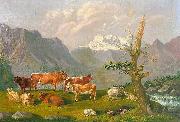 |
Johann Kaspar Scherrer -- Click Here
|
|
painted Weidelandschaft in den Schweizer Bergen mit Katarakt und Gebirgshorizont in 1739 - 1806 |
|
 |
Johann Jakob Ulrich -- Click Here
|
|
impression atist
28 Feb 1798 -- 17 March 1877.
Swiss painter. He first studied under his father and then in Paris in 1822 in the studio of Jean-Victor Bertin. As a student he concentrated on unusual lighting effects in his landscape paintings well before they became a hallmark of the precursors of the Impressionists. In 1824 at the Salon in Paris he first saw paintings by Constable. On a trip to Italy in 1828 he did studies en plein air as preliminary sketches for his studio paintings. His early paintings emphasize brilliant colour, low horizons and scientific observation of cloud formations in a manner similar to Constable's studies, which he actually saw on visits to England in 1832 and 1835. Like Eugene Boudin, Ulrich was interested in poetic evocations of sun, water and effects of atmosphere rather than in the precise delineations of topography typical of Swiss art of that period. From 1824 he showed regularly at the Salons in Paris and in 1837 he returned to Zurich. Because the Swiss public was reluctant to accept his freer, |
|
 |
Johann Jakob Meyer -- Click Here
|
|
b Winterthur, 7 Oct 1763; d Aussersihl, Schwyz, 10 April 1830,Swiss painter and engraver. He studied under Johann Rudolf Schellenburg in Winterthur and then, in 1778, with Heinrich Rieter (1751-1818) in Berne, where he was also influenced by the topographical landscapes of Johann Ludwig Aberli. He was adept at executing such sharply detailed engravings of Swiss cities as View of Lucerne (c. 1790; e.g. Lucerne, Zentbib.), which he sold to tourists. In 1802 he published an important series of views of Switzerland, which were widely circulated. His skill as a painter of animals was sometimes combined with his rendering of the landscape, as in View of the Lake of Bienne (c. 1800; Winterthur, Kstmus.). In 1807 he taught drawing in Basle and in 1814 was active in the area around Lake Constance. His paintings are often characterized by warm colours and frequently capture the atmosphere of late afternoon, as in Murg on the Lake of Walen (c. 1820; St Gall, Kstmus.). Many of his landscapes are straightforward depictions of the Swiss countryside, stressing the romantic nature of the scene, as in View of the Area of Bex (1821; Winterthur, Kstmus.). He painted in Zurich in 1827 and was known to have travelled to Munich and Dresden. His works are important visual documents of an image of the pastoral countryside frequently propagated by Swiss artists in accordance with the philosophical ideals of Jean-Jacques Rousseau |
|
 |
Johann Jakob de Lose -- Click Here
|
|
Johann Jakob de Lose (1755 - 1813), German painter, working in Frankfurt/Main. |
|
 |
Johann Jakob Biedermann -- Click Here
|
|
b Winterthur, 7 Oct 1763; d Aussersihl, Schwyz, 10 April 1830 |
|
 |
Johann Hulsmann -- Click Here
|
|
(1600 -1660 ) - Painter
|
|
 |
Johann Hermann Carmiencke -- Click Here
|
|
Johann Hermann Carmiencke, a landscape painter and etcher, was born at Hamburg in 1810. He went to Dresden in 1831 as a journeyman painter, and while there studied in Dahl's school. Thence he went to Copenhagen in 1834, where he studied in the Academy, and presently repairing to Leipsic, received instruction there from Sohonberg. Returning to Copenhagen in 1838, he proceeded to travel as an artist in Sweden, Bavaria, and the Tyrol, visiting Italy from 1845 to 1846. He was then appointed court painter to Christian VIII, for whom he executed many works. In consequence of the war, he went in 1851 to New York, where he was well received, and admitted into the Academy of Brooklyn. His works were mainly groups of mountain ranges, which were very effectively rendered, and possessed an excellent tone the execution being simple and true to nature. The 'Mountain Tarn' and the 'View on the Zillerthal' may be particularly noticed. There are thirty-five careful etchings of landscapes by him, some of which were published by the Art Association of Copenhagen in 1850 and 1851. He died at New York in 1867. |
|
 |
Johann Henrich Wedekind -- Click Here
|
|
painted Portrait of Empress Anna of Russia in 18th century
|
|
 |
Johann Heinrich Wilhelm Tischbein -- Click Here
|
|
Johann Heinrich Wilhelm Tischbein, also known as Goethe-Tischbein (15 February 1751 - 26 February 1828) was a German painter. He was a descendant of the Tischbein family of painters, and a pupil of his uncle Johann Jacob Tischbein.
|
|
 |
Johann Heinrich Schonfeldt -- Click Here
|
|
German , Biberach 1609-Augsburg 1682/83
|
|
 |
Johann Heinrich Roos -- Click Here
|
|
German Baroque Era Painter, 1631-1685
was a German Baroque era painter and etcher. His works are presented in various art museums worldwide. |
|
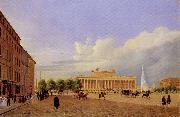 |
Johann Heinrich Hintze -- Click Here
|
|
painted Berlin, Altes Museum von der Schlossfreiheit aus in 1832 |
|
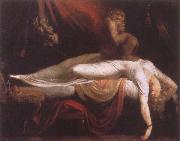 |
Johann Heinrich Fuseli -- Click Here
|
|
1741-1825
Romanticism Swiss
|
|
 |
Johann Gottfried Steffan -- Click Here
|
|
1815-1905
Swiss painter. He moved to Munich in 1833 after an apprenticeship as a lithographer in Wedenswil. He studied at the Akademie der Bildenden Kenste and the Polytechnikum in Munich. He was impressed by Carl Rottmann's Italian landscapes and decided to devote himself to landscape painting. He travelled to Italy in 1845 and to Paris in 1855; he subsequently began to concentrate on painting lake and mountain scenes, for example Lake Starnberg in a Storm (1873; Zurich, Ksthaus), at which he was highly successful. He undertook numerous study-visits to Bavaria and Switzerland, often accompanied by his pupils Traugott Schiess (1834-69) and Otto Frölicher. In Munich Steffan became friendly with Rudolf Koller, Johann Caspar Bosshardt (1823-87) and Arnold Becklin, and under his leadership the 'Schweizer', as these artist-friends were known collectively, formed their own group. |
|
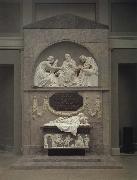 |
Johann Gottfried Schadow -- Click Here
|
|
1764-1850 Berlin, He was a German sculptor. He was born in Berlin, where his father was a poor tailor. Friederike von Preuben.His first teacher was an inferior sculptor, Tassaert, patronized by Frederick the Great; the master offered his daughter in marriage, but the pupil preferred to elope with a girl to Vienna, and the father-in-law not only condoned the offence but furnished money wherewith to visit Italy. Three years' study in Rome formed his style, and in 1788 he returned to Berlin to succeed Tassaert as sculptor to the court and secretary to the Academy. Over half a century he produced upwards of two hundred works, varied in style as in subjects. |
|
 |
Johann Gottfried Auerbach -- Click Here
|
|
Johann Gottfried Auerbach (October 28, 1697 -August 5, 1753), was an Austrian painter and etcher.
Auerbach painted primarily portraits and battle genre works. Some of his works can be found at the Kunsthistorisches Museum. |
|
 |
Johann Geyer -- Click Here
|
|
painted Columbus and the Egg in 1847
1807-1875 |
|
 |
Johann Georg Ziesenis -- Click Here
|
|
(b Copenhagen, 1716; d Hannover, 4 March 1776). German painter of Danish birth. He trained with his father, Johann Georg Ziesenis (1681-1748); he became a German citizen in 1743 and subsequently was appointed court painter to Herzog Christian von Pfalz-Zweibrecken in Zweibrecken and, later, Mannheim. In the early 1750s he overcame his technical shortcomings by studying Flemish art, particularly the work of Rubens and van Dyck. He also introduced a new genre, the private court portrait. His portrait of Karl Philipp Theodor, Kurferst von der Pfalz (1757; Munich, Alte Pin.) is original in its intimate view of a nobleman posed at leisure in casual dress, seated in his private study. |
|
 |
Johann Georg Weikert -- Click Here
|
|
Austria (1743 - 1799 ) - Painter. |
|
 |
Johann Georg von Hamilton -- Click Here
|
|
1672--1737 |
|
 |
Johann Georg von Dillis -- Click Here
|
|
(born Gmain, December 26, 1759 - died Munich, September 28, 1841) was a German painter. Son of a gamekeeper and forester, he was educated in Munich with support from the prince-elector of Bavaria. Initially he was trained for the priesthood, but by 1786 his real interest, art, was beginning to be developed, and he taught drawing both at court and to private families. In 1790 he was appointed inspector of the Hofgarten Galerie, the princely collection. He continued in a curatorial role for the Bavarian court for much of the rest of his career; this allowed him some freedom to travel and expand his knowledge of European art. In 1792 he traveled to Dresden, Prague, and Vienna, and in 1794 he made his first trip to Italy, where he made watercolor studies from nature. A further trip to Italy followed in 1805, and brought him to Rome, where he met Pierre-Henri de Valenciennes, who introduced him to the idea of painting in open air. He studied the work of Simon Denis and Joseph Mallaord William Turner, and encountered Washington Allston. The next year, in Paris, he saw oil sketches by Jean-Joseph-Xavier Bidauld, and with Ludwig, the crown prince visited the Musee Napoleon; he would later advise the prince on collecting and other matters artistic, remaining in this capacity for the rest of his life. He also made several trips to Italy to purchase art for the royal collection. In 1816 he was made responsible for packing and returning to Munich from Paris art stolen from Bavaria by Napoleon. In the fall of 1817 he and Ludwig traveled to Sicily before spending four months in Rome. Dillis helped to shape the collections of the Alte Pinakothek, which opened in 1836. He died in Munich in 1841.
|
|
 |
Johann Georg Meyer -- Click Here
|
|
Johann Georg Meyer (28 October 1813 Bremen, Germany - 4 December 1886 Berlin), commonly known as Meyer von Bremen, was a German painter who specialized in Biblical, peasant, and family scenes.
In his 2lst year, he went to Desseldorf and began his studies at the Academy of Art there, which was led by Friedrich Wilhelm Schadow, the son of sculptor Johann Gottfried Schadow. In 1841, Meyer opened a studio of his own, but moved to Berlin as his fame increased (1853). While scenes from the Bible were first the subjects of his brush, he later turned his attention to incidents from popular life, especially among the Hessian peasantry, and finally to the portrayal of family life in its pathetic aspect. Such pictures as eThe Jubilee of a Hessian Pastore (1843), hristmas Eve,e eBlindman's Buff,e eThe Soldier's Return,e eThe Inundatione (1846), eThe Repentant Daughtere (1852, in the gallery at Bremen), are full of intense sympathy with the esimple annals of the poor.e After taking up his residence at Berlin, he chose especially scenes from child life, which he rendered with spirited humor. Among his pictures of this kind are eThe Fairy Tale,ehildren Playing Blindman's Buff,e eGrandfather and Grandchild,e and others. A third group of his pictures includes those of young women, as single figures or in groups, such as eThe Tryste and eThe Love Letter.e An example of his work, eThe Lettere (1873), is in the Metropolitan Museum of Art in New York City. |
|
 |
Johann Georg Grimm -- Click Here
|
|
painted Arabische Gasse in |
|
 |
Johann Georg Edlinger -- Click Here
|
|
painted Family Portrait in 1800 |
|
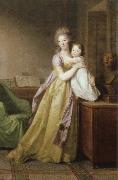 |
johann friedrich august tischbein -- Click Here
|
|
German Painter, 1750-1812. 1750 Maastricht ?C Heidelberg 1812. First he was a pupil of his father Johann Valentin Tischbein (1715-1768) in Hildburghausen, from 1768 one of his uncle Johann Heinrich Tischbein the elder (1722-1789) in Kassel.
Supported by Prince Friedrich von Waldeck he stayed in Paris from 1772 until 1777, where he studied at the academy of arts under N. B. L??pici?? (1735-1784).
Afterwards he travelled to Rome, where he got in contact with the painters A.R. Mengs (1728-1779), J.L. David (1748-1825) and Fr.H. F??ger (1751-1818) and probably also with the English style of portrait painting. 1779 he travelled to Naples.
In 1780 he returned to Arolsen via Vienna, Munich, Stuttgart and Kassel, where he worked for the Prince of Waldeck. From 1780 he was his councillor
and court painter. During this time he made several journeys e.g. to Holland and after 1785 to Weimar where he met Wieland (1785), Schlegel (1792) and other important people.
From 1795 he worked for Leopold III. of Anhalt-Dessau. 1800 he succeeded A. Fr. Oeser (1717-1799) as director of the academy of arts in Leipzig. From 1806 to 1808 he stayed in St Petersburg. He died 1812 when he visited his daughter Caroline Wilken (1783-1843) in Heidelberg
|
|
 |
Johann Evangelist -- Click Here
|
|
Johann Evangelist Holzer (December 24, 1709 - July 21, 1740) was an Austrian-German painter.
Holzer was born in Burgeis, Mals, in the Vinschgau Valley of South Tyrol, as the son of a miller. He was sent to undertake a classical course of study at Marienberg Abbey, but wished to study art; a portrait he painted of Johann Baptist Murr, then the abbot of the abbey, convinced his father to yield to his wishes. He studied under Nikolaus Auer and made rapid progress. At the age of 18 he painted the altarpiece of the Marienberg Abbey church, depicting Saint Joseph as patron of the afflicted, ill, and dying. He then went to Straubing, where he learned under Joseph Anton Merz how to paint frescos, which would become the main source of his later fame. He helped Merz paint the frescos of Oberalteich Abbey, and while in Straubing also painted Saint Anthony of Padua for the Franciscan church there.
1738/39 was in the painting of Eichstätt for the high altar of the Schutzengelkirche It is Holzer's largest painting on canvas (H: 8,36 m; B: 4,28 m) and impresses through movement, gesture, a dynamic composition, and a sophisticated lighting design. Although there are two pictures (side altars) signatures of Bergmeller, they will Holzer, assigned by the archives occupied painter of the high altar painting. |
|
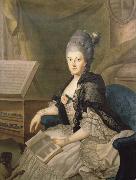 |
Johann Ernst Heinsius -- Click Here
|
|
German, 1740-1812 |
|
 |
Johann Erdmann Hummel -- Click Here
|
|
1769 Kassel-1852 Berlin,German painter and writer. He studied from 1782 in the architecture class at the Akademie der Bildenden K?nste at Kassel and subsequently under the Kassel court painter, Wilhelm B?ttner. Hummel retained his connection with architecture, however, and this is manifested in his overpowering concern with structure and perspective. The Kassel court granted Hummel funds for travel and study in Italy and, in 1792, he went to Rome, where he joined a group of fellow Germans, including the painters Johann Christian Reinhart, Johann Martin von Rohden, Friedrich Bury and the architect Friedrich Weinbrenner. In 1796 Joseph Anton Koch joined the group. Hummel also attended the philosophical lectures given by Carl Ludwig Fernow (1763-1808) and became a friend of the archaeologist Aloys Hirt. In Rome, |
|
 |
Johann Conrad Seekatz -- Click Here
|
|
1719-1768 Rococo,German,German painter. He studied with his brother, Johann Ludwig Seekatz (b 1711), and with Philipp Hieronymus Brinckmann (1709-61) in Mannheim (1748-51); he became court painter to Landgraf Ludwig VIII von Hesse-Darmstadt in Darmstadt in 1753. |
|
 |
Johann Christoph Rincklake -- Click Here
|
|
Johann Christoph Rincklake (1764-1813).
Date of birth and death 19 October 1764(1764-10-19) and 19 June 1813(1813-06-19) .
Location of birth and death, Harsewinkel and Munster. |
|
 |
Johann Christian Reinhart -- Click Here
|
|
German , 1761-1847
He revealed an interest in art while still at school and, though he began to study theology in Leipzig in 1778, he soon transferred to the private art academy of Adam Friedrich Oeser (1717-99). Here he made copies of the work of his teacher and drew after plaster casts of antique statues. The Liber Veritatis, a collection of 200 drawings by Claude Lorrain, was also used as a model and had an important influence on him. In 1783 he went to Dresden where he was especially attracted to the Dutch landscape paintings in the Gem?ldegalerie. In 1785 Reinhart returned to Leipzig where he made the acquaintance of the German poet Friedrich Schiller, with whom he had a lifelong friendship, and to whom he later dedicated an etching of a heroic landscape (1800). From 1786 to 1789, while resident at the court of the Duke of Sachsen-Meiningen, he explored the Thuringian countryside on foot, making sketches as he went. |
|
 |
Johann Christian Klengel -- Click Here
|
|
Johann Christian Klengel (1751-1824), painter. |
|
 |
johann christian Claussen Dahl -- Click Here
|
|
1788-1857 |
|
 |
Johann Christian Brand -- Click Here
|
|
(March 6, 1722 ?C June 12, 1795)was an Austrian painter (son of the German painter Christian Hilfgott Brand (1694-1756) who taught in Vienna with Karl Aigen) and brother of Friedrich August Brand.Johann Christian Brand influenced ending the baroque era of landscape painting. He died in Vienna.
Johann Christian Brand was born in Vienna on March 6, 1722. Influential in ending the baroque era, Johann studied at the Vienna Academy from 1736.He was awarded with the titles Kammermaler* in 1766 and "Professor of Landscape Drawing" in 1772. |
|
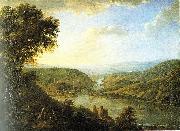 |
Johann Caspar Schneider -- Click Here
|
|
Rhine valley by Johann Caspar Schneider in 1820 |
|
 |
Johann Carl Wilck -- Click Here
|
|
Johann Carl Wilck (1772 - 1819) |
|
 |
Johann Carl Loth -- Click Here
|
|
German Baroque Era Painter, 1632-1698
was a German painter, born in Munich but active most of his life in Venice. He is also called Johann Karl, Carlotto, and Carlo Lotti. He was the son and pupil of Johann Ulrich Loth (1590- 1662). He was commissioned to paint for the emperor Leopold in Vienna. He was influenced by Pietro Liberi. His brother Franz Loth was also a painter in Venice and Germany. He had numerous pupils including Willem Drost, Cornelis de Bruijn, Johann Michael Rottmayr, Paul Strudel, Santo Prunati, Daniel Seiter, and Giovan Battista Langetti. |
|
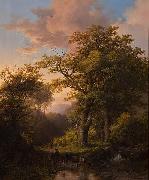 |
Johann Bernhard Klombeck -- Click Here
|
|
painted A Forest Scene in 1857 |
|
 |
Johann Barthold Jongkind -- Click Here
|
|
1819-1891
Dutch
Johann Barthold Jongkind Gallery
was a Dutch painter and printmaker regarded as a forerunner of Impressionism who influenced Claude Monet.
Jongkind was born in the town of Lattrop in the Overijssel province of the Netherlands near the border with Germany. Trained at the art academy in The Hague, in 1846 he moved to the Montmartre quarter of Paris, France where he studied under Eugene Isabey and Francois-Edouard Picot. Two years later, the Paris Salon accepted his work for its exhibition, and he received acclaim from critic Charles Baudelaire and later on from Emile Zola. Jongkind was to experience little success, however, and he suffered bouts of depression complicated by alcoholism. Jongkind returned to live in Rotterdam in 1855, and remained there until 1860. Back in Paris, in 1861 he rented a studio on the rue de Chevreuse in Montparnasse where some of his paintings began to show glimpses of the Impressionist style to come. In 1862 he befriended the young Claude Monet who later referred to Jongkind as the "master." The following year Jongkind exhibited at the first Salon des Refus??s. Despite several successes, in another of his down periods the Impressionist group did not accept his work for their first exhibition in 1874. In 1878 with his wife, painter of nude people Josephine Fesser, Jongkind moved to live in the small town of La Cote-Saint-Andre near Grenoble in the Isere departement in the southeast of France where he died in 1891. He is buried there in the local cemetery. |
|
 |
Johann Baptist Seele -- Click Here
|
|
Germany (1774 -1814 ) |
|
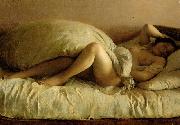 |
Johann Baptist Reiter -- Click Here
|
|
painted Slumbering Woman in 1849 |
|
 |
Johann anton ramboux -- Click Here
|
|
German, 1790 - 1866
German painter, draughtsman and museum curator. He was taught drawing by Jean-Henri Gilson (1741-1809), before he went to Paris for further training in the studio of Jacques-Louis David. In 1812 he returned to Trier, painting portraits until 1815, when he spent a year at the Akademie der Bildenden K?nste in Munich. In 1816 he went to Rome, where he was part of the Nazarene circle without becoming a member of the Lukasbr?der. Close association with these artists, notably Peter Cornelius, Carl Philipp Fohr and Julius Schnorr von Carolsfeld, had a more lasting influence on Ramboux's artistic development than his earlier studies with David |
|
 |
Johann Anton Eismann -- Click Here
|
|
(1604-1698) was an Austrian painter.
Eismann was born in Salzburg, and was active in Verona and Venice. He painted primarily harbor and some battle genre scenes. He died in Venice in 1698. |
|
 |
johan zacharias blackstadiusblackstadius -- Click Here
|
|
seated female model
december1842.
royal academy of fine arts |
|
|
|
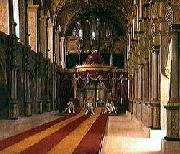 |
Johan Vilhelm Gertner -- Click Here
|
|
(10 March 1818 - 28 March 1871) was a Danish painter, best known for his portraiture. One of the last students of Christoffer Wilhelm Eckersberg, who was known as the father of the Golden Age of Danish Painting, Gertner belonged to the tail end of the Golden Age, a period during which Danish art moved towards a more realistic style, relying on inspiration both from French Realism and emerging photographic techniques.
Gertner was born on 10 March 1818 to a craftsman at the Holmen naval base. He attended the Royal Danish Academy of Fine Arts from 1831 to 1837 where he was one of Christoffer Wilhelm Eckersberg, known as the farther of Goldn Age of Danish Painting. Eckersberg taught him a naturalistic approach to painting, but Gertner went much further with inspiration from French art and the emerging techniques of photography.
His virtuosity in producing almost photographically precise portraits impressed many; in particular, his ability to reproduce textures and materials e crisp silk dresses, lustrous medals and jewellery, dark mahogany furniture, silky wallpapers, and soft carpets e won him much acclaim. Others, such as the influential art historian and critic Niels Lauritz Høyen, who opposed any foreign influence on Danish painting, disapproved of his style, preferring more sincere and sensitive portrayals. He was a professor at the Academy from 1858.
|
|
|
|
 |
Johan Thorn Prikker -- Click Here
|
|
1868-1932 Dutch Johan Thorn Prikker Gallery
Dutch painter, printmaker, mosaicist and stained-glass artist. He attended the Koninklijke Academie van Beeldende Kunsten in The Hague (1881-8). During this period he painted mainly landscapes in the style of The Hague school. Until c. 1896 he produced Symbolist works, in which the emphatic line flow and the subtle colour shading are especially noticeable, for example The Bride (1893; Otterlo, Kr?ller-M?ller). From 1892 until 1897 he corresponded with Henri Borel, partly about his Symbolist work, often drawing in the letters. During this time he came into close contact with Belgian artists, in particular with Henry Van de Velde through whom he was able to exhibit with Les XX in Brussels. In summer he regularly stayed in Vise, where he produced pastel drawings in a rhythmic pointillism, a style with which he could achieve a form of abstraction. |
|
 |
Johan Thim -- Click Here
|
|
painted Jørgen Rosenkrantz in 1640 |
|
 |
Johan Stalbom -- Click Here
|
|
Johan Stalbom (1712 - 1777) |
|
 |
Johan Richter -- Click Here
|
|
(1665 - 1745) was a Baroque painter, born in Sweden, but painting mainly landscapes or veduta of Venice.
Richter was born in Stockholm and died in Venice. He was known to be active in Venice by 1717. He was influenced by Luca Carlevarijs.
|
|
|
|
|
|
|
| | |
|
|
|
|